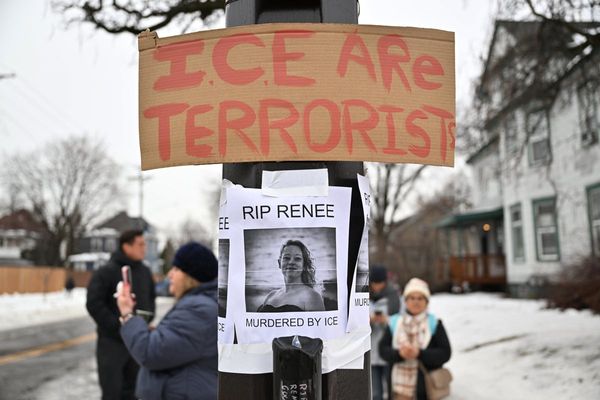
The Environmental Protection Agency has announced more stringent rules governing offshore oil spill response, amid continuing concerns about the effects on public health and wildlife from chemical disasters, including BP’s Deepwater Horizon explosion in 2010.
The federal agency, which announced the update on Monday, had not updated its rule regulating the chemicals used to break up offshore oil slicks since 1994.
Five environmental organizations, an Alaskan tribal leader and a south Louisiana fisher sued the EPA in 2020 to force the agency to update its regulations based on lessons learned from the BP oil spill and the Exxon Valdez oil spill in 1989. In 2021, US district court judge William Orrick ordered the EPA to update its oil spill response plans.
Thousands of people who rushed into Gulf of Mexico waters to clean up BP’s oil spill have fallen ill, and some have died. A recent Guardian investigation spotlighted the difficult legal fight that cleanup workers who got sick have been experiencing trying to bring medical cases against the oil giant.
More than three decades earlier, those who cleaned up the Exxon Valdez oil tanker spill off the coast of Alaska suffered the same fate. A growing body of research has linked exposure to the dispersants used by BP to break up oil slicks with chronic illnesses, including increased risk of cancer, heart conditions and an increased rate of births of premature and underweight infants.
The updated EPA rule, which takes effect in December, requires dispersants to undergo more stringent toxicity and efficacy testing before they can be approved for use. Dispersants currently approved by the agency must undergo retesting under the new criteria. Products not retested within two years after the rule takes effect or that do not meet the new criteria will be removed from the approved list, according to the updated regulations.
Riki Ott, an Alaska toxicologist, began advocating for protections for oil spill cleanup workers in the wake of the 1989 Exxon Valdez oil spill and is the director of Earth Island Institute’s Alert Project, the lead plaintiff in the case against the EPA. “What heartened me was the shift to holding the industry more accountable for its own product use by requiring things that should have been required decades ago,” she said.
During the BP spill, millions of gallons of dispersants were pumped underwater to the gushing wellhead and sprayed from planes flying over the Gulf. Calls by members of Congress and public health advocates for a list of chemicals found in the dispersants went unanswered by the company that produced the products, Nalco Holding Co, for weeks during the spill. Nalco said that the ingredients in its products were “confidential business information” and disclosing the chemicals would put the company’s competitive edge at risk. Eventually, a full list of the chemical components was released by the EPA.

The updated rule no longer allows companies to hide the chemical ingredients of their products. “Prompt and accurate information will allow the public to evaluate and understand the potential human and environmental effects of these chemical agents,” according to the amended EPA rule.
There is also a provision in the rule that allows the EPA to remove products from the approved list of dispersants if a company provides misleading or inaccurate information about what’s in their product or its potential to cause harm. The recent report by the Guardian found that during the BP spill, the oil giant provided cleanup workers with training modules that claimed dispersants used in the Gulf had no ingredients known to cause chronic health effects. “What has happened to the BP workers and coastal residents with all these illnesses and lingering harm and sick and dying children. Nobody wants that to happen again,” Ott said.
The updated rule also addresses concerns from Alaska community groups about the effectiveness of dispersants in Arctic waters by requiring companies to test their products in two different temperatures, 5 and 25C. “I think it’s going to be eye-opening for how many of these chemicals actually work when you get down to 5C,” said Sue Mauger, the executive director of Cook Inletkeeper, one of the plaintiffs in the suit against the EPA.
More drilling
Although Joe Biden campaigned on a promise of halting new drilling on federal land and in federal waters in the face of climate change, new leases were auctioned to fossil fuel firms in the Gulf of Mexico in March and in Alaska’s Cook Inlet in December. The Alaska oil lease sale moved forward under the assumption there is a 19% chance that a large oil spill would happen if more offshore development occurred, according to the Environmental Impact Statement prepared by the US Department of the Interior.
Mauger questioned if drilling could continue off the coast of Alaska if companies do not have the option of using dispersants to clean up future oil spills. “I think there ought to be a real serious consideration for not allowing offshore drilling in cold waters,” she said.
But Kindra Arnesen, another plaintiff in the case against the EPA, is not ready to celebrate the rule updates. Arnesen, a south Louisiana commercial fisher, said there were more steps ahead to banning the dispersants that she said made her husband and children sick in the wake of the BP spill. “I don’t think this new rule has enough teeth in it to protect my community,” she said.
The new rule gives more authority to state and local officials in the decision to use dispersants. In an oil producing state like Louisiana, Arnesen said that may not be a good thing. “Our people will never see justice for the impacts caused by the BP disaster in 2010,” she said. “If it’s left up to the state of Louisiana, the community members will be the tradeoff every time for oil and gas.”







